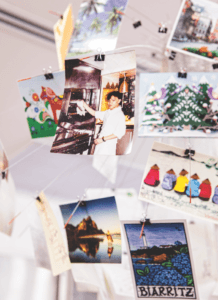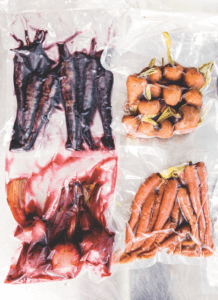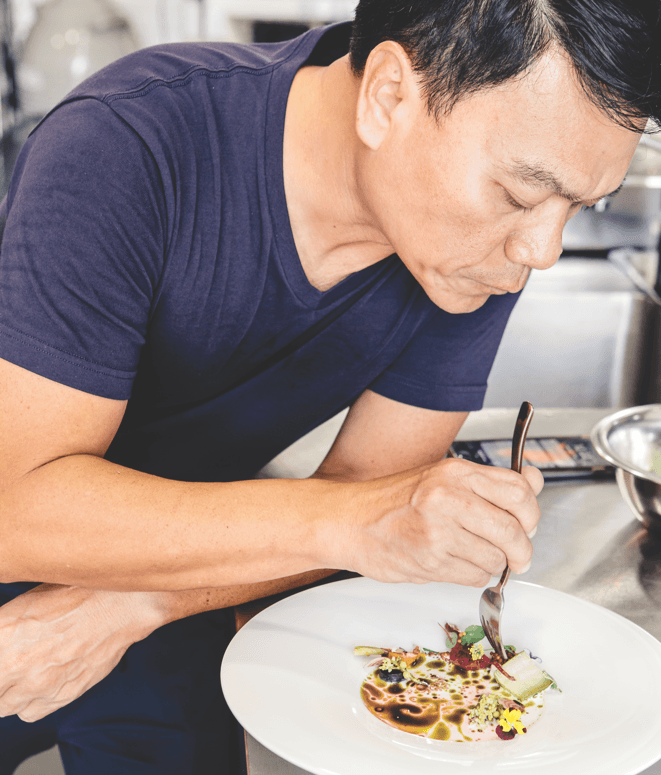By Duncan Forgan | Photography by Christopher Wise
The streets that extend like tendrils from Sukhumvit Road offer some of Bangkok’s richest gastronomic rewards. Legendary restaurants dish out specialties from across Thailand’s culinary spectrum—a palette that includes everything from grilled meats and Chinese-influenced stir-fries to fiery soups, curries, and salads. On the sidewalks, vendors tend to giant broth-stained terrines and maneuver sizzling woks over charcoal burners; the chatter from their customers cuts through the broiling tropical heat like galangal in a chili-laden tom yam sour-spicy soup.
A short distance away, in a stately villa tucked into one of the area’s quieter lanes, Ian Kittichai is busy with his own brand of Thai culinary alchemy at Cuisine Concept, the chef’s recently minted kitchen lab.
As he flits between a giant Retigo combination oven and a center island equipped with burners, steamers, planchas, bains marie, and other gadgets, Thailand’s most famous chef is in his element, a genius scientist in his high-tech workroom. Today he is testing vegetable dishes and other items for his flagship Bangkok restaurant Issaya Siamese Club. These recipes aren’t strictly new, though. They are updated versions of dishes that date as far back as 500 years. This synergy between past, present, and future is the perfect illustration of Kittichai’s long-term mission as a chef—a journey that has seen him achieve global prominence by marrying innovation to the tenets of traditional Thai cuisine.
“The way that Thais eat has changed,” he says, stopping to check on the free-range chicken from an organic farm in Khao Yai that he is slow-cooking sous vide with coconut and turmeric. “People want authenticity, but they also want delicacy. They want refinement. They want a protein that is tender, juicy, and flavorful. At least that’s my interpretation of how Thai food is best enjoyed. That’s why I like to use different techniques to present Thai cuisine at its highest level.”
Kittichai’s industriousness in his kitchen lab is a testament to the chef’s dogged work ethic. When Sous-Vide visits, the Songkran (Thai New Year) holiday is about to start. The summer weather has been so searing that elephants at Thailand’s zoos are being fed special frozen fruit pops to cool them down. It is the ideal time of year for perfecting the ancient Thai art of taking it easy.
Respite, though, is a rare luxury for Kittichai. The next day will see him jet off to Singapore to take part in a four-hands dinner. And, of course, there’s the matter of overseeing a global culinary empire that spans three continents: Asia, North America, and Europe.

His business interests are many and varied. In Bangkok, he runs two restaurants—Issaya Siamese Club and Namsaah Bottling Trust—plus a patisserie, a cooking school, and now Cuisine Concept, which doubles as a space used for everything from product launches and video shoots to hosting events such as the 2019 International Sous Vide Day celebration. Other notable ventures include Spot Dessert Bar in New York and Tangerine in Singapore. Add his television shows, consultancies, and cookbooks into the mix, and it is little wonder that Kittichai seems to be a man in perpetual motion.
As he pours himself a glass of water, an aide approaches to ask if he is able to handle a chef’s table for a corporate group later in the month. “I’ll check my calendar,” he says, a hint of doubt creasing his face. “But I’m not sure that I’ll be available anytime soon.”
Being busy is second nature for Kittichai. He’s been a lifelong multi-tasker. As a teenager, his day started at 2:30 am when he drove a truck to Bangkok’s famous Khlong Toei wet market to help his mother snare fresh produce to sell at the family greengrocer and street food cart. Then he went to school. “It was 365 days a year—very full on,” he recalls with a grimace.
Other less-than-salubrious stepping stones in his career include a stint as a pot-washer at London’s Waldorf Hotel (now the Waldorf Hilton, London), time at culinary schools in London and Sydney, and a long apprenticeship at Claude’s, a famous French restaurant in Sydney. Back in Bangkok, he swiftly rose through the ranks at the Four Seasons hotel, becoming executive chef by the age of 30. These days, his relationship with food is mostly glamorous—and much better rewarded than your average produce truck driver. But he is barely less occupied.

Thankfully, the frantic schedule does not seem to have dampened the chef’s enthusiasm for his craft. “Food testing, recipe testing: I can do just about anything here,” he says, gesturing around the state-of-the-art kitchen at Cuisine Concept. “We refine everything. Not only is it more efficient in terms of working in a larger kitchen, but it also offers a lot of privacy. I have lots of things that I want to do, and this place gives me the chance to fine-tune all my recipes and ideas.”
One of the cooking methods Kittichai is most enthusiastic about is sous vide, a technique he first encountered in 1993 at the Four Seasons in Bangkok (today, the property is the Anantara Siam Bangkok Hotel). “There was a visiting chef—I can’t remember his name, but he was Swiss—and he vacuum-sealed a foie gras terrine and cooked it in a combi oven,” Kittichai remembers. “At the time, sous vide was completely unknown in Thailand, so that really had a huge impact on me.”
The chef soon received further education in the technique on one of what he calls his “working vacations”—extended stints away from Bangkok at some of the world’s top restaurants, such as El Bulli in Catalonia and the French Laundry in California.
At the latter, he took notes as chefs Thomas Keller and Eric Ziebold slow-cooked proteins like rabbit and lamb. He was hooked. Kittichai and his wife and business partner Sarah Chang attended a five-day course on sous vide at the International Culinary Center (formerly the French Culinary Institute) in New York in 2006. By December, they were cooking a turkey sous vide for Christmas dinner. “I think it was delicious,” the chef says, laughing. “But we did drink a lot of wine.”
Joking aside, sous vide has since become a vital part of Kittichai’s culinary armory. Indeed, many of his restaurant signatures were devised with the technique in mind. Menu standouts at Issaya Siamese Club, for instance, include a lamb shank massaman (a rich, mild curry from southern Thailand that is spiced with cardamom, cloves, cinnamon, and star anise) and a version of the northern Thai/Burmese khao soi (noodles with coconut milk and turmeric) made with veal shanks. The lamb is seared and then cooked for 10 hours at 176°F (80°C), resulting in meat that practically melts off the bone. The veal shanks are cooked for 12 hours at the same temperature, a preparation that similarly melts the sinews in the muscle-bound meat into a lush, glossy gravy.
Sous vide is known for guaranteeing consistently tender, juicy proteins: factors that endear the technique to most professional chefs around the world. For his part, though, Kittichai believes that sous vide’s potential for deep infusion makes it particularly well-suited to Thai cuisine.

“Sous vide is a godsend,” he says. “I can put a curry paste or a sauce into the bag and the meat cooks with the sauce. You have the flavor of the meat in the curry and you have the flavor of the curry in the meat. If you want to taste lemongrass, you smash some lemongrass and put it in the bag with the meat. You might not see the lemongrass on the plate at the end, but you taste it.”
If it sounds like Kittichai is obsessed with ways to maximize the potential of Thai food, that’s because he is. When he launched Kittichai, his first stand-alone restaurant, in New York in 2003, Thai cuisine was often considered an exotic novelty, not quite fit to rank alongside classic European fine dining. In 2011, when he opened Issaya Siamese Club in Bangkok, his venue was one of a very select handful presenting Thai food in new ways, often using premium produce.
Attitudes have shifted dramatically over the past decade or so. Thai restaurants are perennial hits in food capitals around the world. In Bangkok, meanwhile, a buzzing dining scene (encouraged enormously by the entry of the French fine dining bible, the Michelin Guide, to Thailand) is providing a stage for gifted young Thai chefs to push the limits of their native cuisine, and also to branch out in new directions.
“It’s encouraging to see,” Kittichai says of a crop of Michelin star winners and hopefuls including Saawaan, Sorn, 80/20, and the Front Room. “These venues all have their own unique approach. They are coming up with different ways of presenting Thai food, and that’s phenomenal.” As for Kittichai, he’s got plenty on his plate. This year, he plans to open several new outlets worldwide and has a number of new brands and collaborations in the works. But, he says, as he hangs up his whites and turns out the lights at his lab, he plans to gravitate back towards the kitchen as much as time will allow.
“I get to do so many different things. It’s so varied and interesting. I couldn’t ask for more,” he says. “But when I put my chef’s jacket on, I feel like I’m a superhero or something. When a customer comes to me and tells me that ‘This is the best thing I have tasted this year,’ I can’t imagine a better feeling than that.”
This article originally appeared in Sous-Vide magazine’s Fall/Winter 2019 issue. Read the complete print archive here.
Related Articles VIEW ALL ARTICLES
Chefs & Personalities
On Her Own
Mei Lin earned her stripes in some prestigious kitchens—and now she’s developing her own legacy through her new Los Angeles solo project, Nightshade.
Read More >Chefs & Personalities
Culinary King
José Andrés created a food empire through a singular focus on innovative cooking. Now he's applying that same passion and drive to a new arena: Humanitarianism.
Read More >

